Myron G. Best. Igneous and metamorphic 2003 Blackwell Science
Подождите немного. Документ загружается.

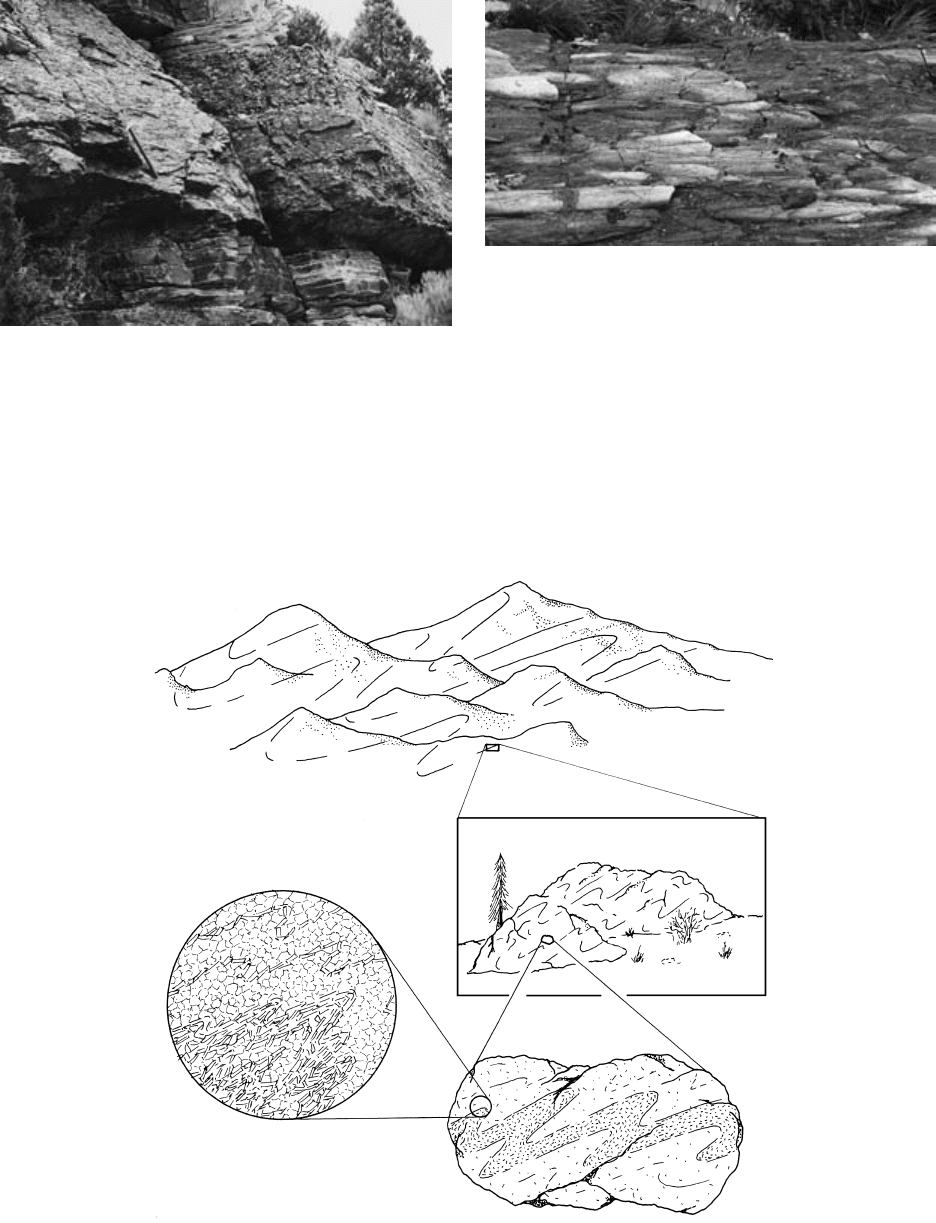
Metamorphic Rocks and Metamorphism: An Overview
417
(a) (b)
14.13 Metaconglomerate produced by recrystallization and ductile flow under nonhydrostatic stress. Compare with Figure 14.12. Outcrop
in regionally metamorphosed late Proterozoic–early Paleozoic rocks, Raft River Mountains metamorphic core complex, northwestern
Utah (see Figure 18.11). (a) Hammer rests on a nearly horizontal relict bed of conglomerate that lies between beds of metamorphosed
quartzo-feldspathic sandstone, now schist. Entire cliff exposure is a strongly foliated and lineated tectonite. (b) View looking down
onto foliation defined by similar orientation of flattened relict cobbles; their common direction of elongation defines a lineation. Note
pocket knife for scale.
Mountain range
Outcrop
Thin section
Hand sample
14.14 Many terranes of regionally metamorphosed rock have been homogeneously deformed on all scales of observation—from mountain
range down to thin section. This penetrative anisotropic tectonite fabric is, therefore, scale invariant and fractal-like. In this hypothetical
diagram, looking down the axis of folds, their orientation and style are the same regardless of the size of the area observed.
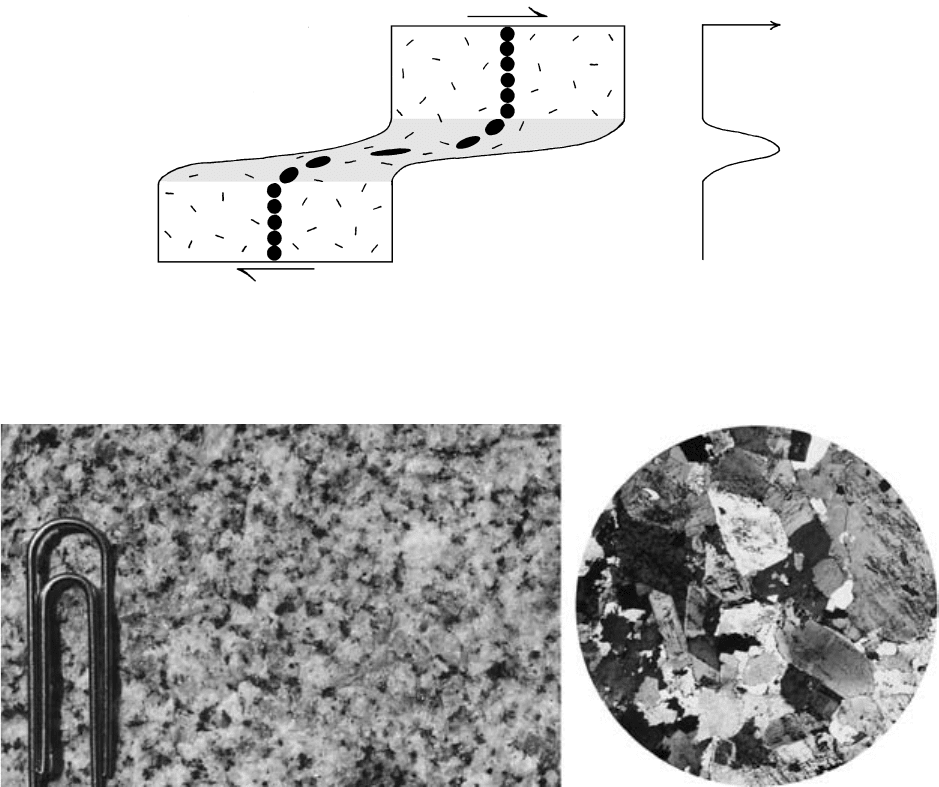
418 Igneous and Metamorphic Petrology
14.16 Progressive mylonitization and development of tectonite fabric in granitic rock, southeastern San Gabriel Mountains, California.
Hand-sample photographs on left are about natural size. Photomicrographs on right are enlarged about 10; thin sections are cut
perpendicular to foliation where present. (a) Original granitic rock. Photomicrograph under cross-polarized light. (b) Hand sample of
slightly deformed rock has a subtle streaked appearance on a faint foliation. Photomicrograph under cross-polarized light discloses many
finer grains. (c) More advanced deformation has produced a conspicuously foliated and fine-grained mylonite with numerous larger relict
feldspars. These feldspars, called porphyroclasts, have greater ductile strength and are less susceptible to deformation than quartz
(Figure 8.8), which has been preferentially deformed to make the fine-grained matrix. Well defined lineation is obvious on foliation in
hand sample. (d) Uniformly very fine-grained, strongly foliated mylonite that also qualifies, in a descriptive nongenetic sense, as slate. No
lineation is visible on foliation in hand sample. Samples collected by Raymond M. Alf. From Shelton JS. Geology Illustrated. New York,
W. H. Freeman, 1966. Reproduced with permission of John S. Shelton, who holds the copyright.
deformation process. Mylonites typically develop in
ductile shear zones (Figure 14.15) where high rates of
strain are focused into relatively thin layers; such zones
are the deep crustal counterparts of more shallow
brittle faults where cataclasis breaks rocks into pieces
(Figure 8.9). Shear zones can evolve over long periods
of time and there is ample opportunity for complex
overprinting of brittle and ductile fabrics. Interpreta-
tions must, therefore, be made cautiously.
Figure 14.16 shows the effects of progressive
mylonitization of a phaneritic granitoid protolith. The
final end-product is an exceedingly fine grained
felsic mylonite is flint-like. Although early investigators
believed mylonites originated by brittle pulverization
(mylonite is from the Greek mylon, to mill), it is now
generally agreed that they are a result of ductile defor-
mation. The typifying grain-size reduction in mylonites
originates from a dynamic interplay between destruc-
tive grain deformation under nonhydrostatic stress and
constructive dynamic recrystallization. This is a ductile
process where higher energy strained grains, whose
stored work of distorting their atomic structures makes
them unstable, are continuously replaced by lower
energy strain-free grains of smaller size during the
Strain rate
Shear zone
14.15 Schematic profile of a ductile shear zone (shaded) in a protolith that has isotropic fabric outside zone. Reference strain ellipses (black)
show partitioning (focusing) of strain into a narrow zone where the strain rate is exceptionally high.
(a)
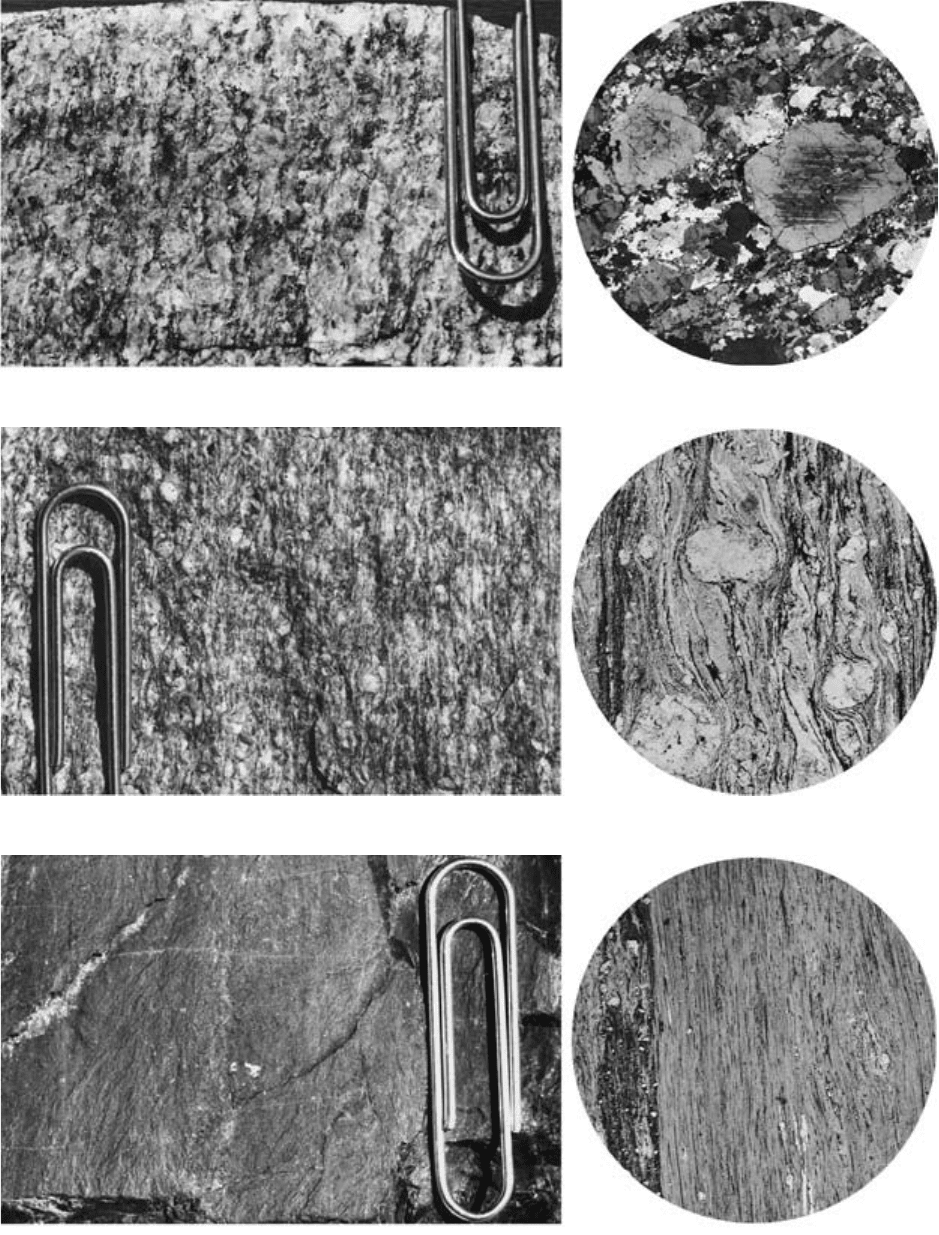
14.16 (Continued).
(b)
(c)
(d)
Metamorphic Rocks and Metamorphism: An Overview
419
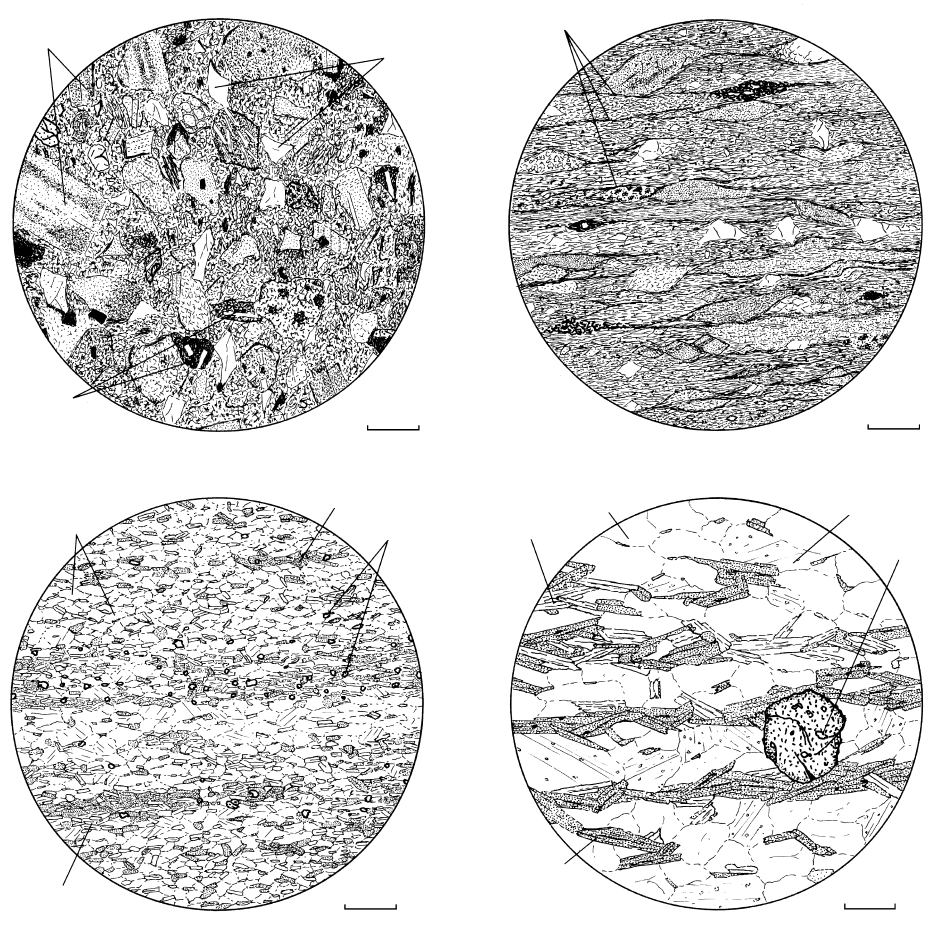
420 Igneous and Metamorphic Petrology
(a)
Lithic
fragment
Feldspar
(b)
Slip surfaces
Quartz
0.5 mm 0.5 mm
(c)
Muscovite
Quartz
albite
(d)
Muscovite
Quartz
Chlorite
Epidote
0.5 mm 0.5 mm
Oligoclase
Garnet
Biotite
14.17 Progressive metamorphism and development of tectonite fabric in lithic wacke (graywacke), South Island, New Zealand. Within the
thick, areally extensive sequence of low-grade rocks, Turner (1981) distinguished four textural zones that can be distinguished in these
thin section views. (a) Original rock in textural zone 1 is composed of clasts of quartz, feldspar, ferromagnesian minerals, and volcanic
rock (lithic fragment) in a clay matrix. Fabric is isotropic. Plagioclase and alkali feldspar are extensively altered to secondary Ca–Al
silicates and sericite, respectively. (b) Foliated metagraywacke or phyllite of textural zone 2. Relict clasts, especially of quartz, are still evi-
dent even though the rock has been pervasively deformed, reducing the size of coarser grains and promoting development of through-
going cleavage surfaces, commonly marked by films of iron oxide that might be a residue after pressure solution (see Section 17.2.1).
Recrystallization of some of the original clasts and clay matrix has produced new but very small grains of quartz epidote albite
chlorite white mica, the latter two forming platy grains, which, because of a strong preferred orientation, enhance the foliation. (c)
Aphanitic phyllite of textural zone 3. Continued growth of new mineral grains under nonhydrostatic stress has produced a well foliated
rock in which all vestiges of the original sandstone fabric and mineral composition have been erased. Note subtle segregation of miner-
als into alternating layers rich in quartz albite and in chlorite epidote. (d) Fine-grained schist of textural zone 4. Continued crystal
growth under nonhydrostatic stress has produced still coarser grains, platy ones possessing a strong preferred orientation which makes
a foliated fabric. This schistosity is enhanced by segregation layers of quartz oligoclase and of muscovite biotite. Oligoclase grains
are distinguished from quartz by cleavage and small mineral inclusions. Assemblage in (c) of chlorite epidote albite has reacted in
prograde manner to an assemblage in this rock of biotite garnet oligoclase.

(aphanitic) and foliated mylonite. In a metamorphic
rock classification based solely on fabric, this rock
qualifies as a slate, despite its granitoid protolith! The
name “slate” carries no connotation as to origin or
protolith, although to most readers slates are derived
from shales.
Transformation of Graywacke into Schist. A thick se-
quence of rocks in the South Island of New Zealand
(see Figure 18.30) shows progressive metamorphism
and development of tectonite fabric from an initially
isotropic protolith of feldspathic and lithic sandstones,
sometimes called graywackes (Figure 14.17). The
changes in these rocks are a result not simply of deep
burial at increasing P and T but also of increasing
degree of recrystallization under nonhydrostatic stress.
Widespread folds attest to the deformation in these
tectonites. Although the feldspar and quartz grains in
the final end result—a schist—have 120° triple junc-
tions resembling granoblastic texture, the aligned platy
minerals and slightly flattened felsic minerals define an
anisotropic tectonite fabric. Significantly, in the more
recrystallized, coarser rocks, the foliation expressed
by the aligned platy minerals is augmented by parallel
layers of contrasting composition that are another ex-
pression of metamorphic differentiation. Like growth
of porphyroblasts, mineral components moved dif-
ferentially during recrystallization but rather than to
isolated crystal nuclei they somehow segregated into
planar layers. This ordering seems to defy the law of
spontaneously increasing entropy. Whatever its origin,
metamorphic differentiation can create compositional
layers where none previously existed. Hence, com-
positional layers in a metasedimentary rock do not
necessarily represent relict bedding. Careful attention
must be paid to the degree of recrystallization, grain
size, and possible preservation of a relict fabric, as well
as field relations, to accurately interpret the origin of
compositional layering.
Slaty and Crenulation Cleavage. Slates possess a slaty
cleavage defined by aligned aphanitic platy phyllosilic-
ates (micas and chlorite) and commonly minute flakes
of graphite. Thin, quartz-rich layers and less continu-
ous lenses may also occur and these can be locally, but
not necessarily, subparallel to the slaty cleavage. Subtle
gradational changes in grain size within the quartz-rich
layers, together with the very fine overall grain size of
the rock, suggest little recrystallization has occurred.
Hence, it is reasonable to interpret the compositional-
textural layering as relict sedimentary interbeds of
siltstone and sandstone in shale. Low-grade meta-
morphism created bedding-parallel flakes of micas
and chlorites that nucleated and grew in the pro-
tolith, mimicking the orientation of the original flat
clay particles. In a later deformation event this slaty
cleavage can be crenulated so that limbs of the over-
printing crenulations define a second, oblique foliation
—a crenulation cleavage (Figure 14.18). This is
another example of polymetamorphism.
Transposition. Existing compositional layers or other
types of foliation in a metamorphic body can be
sheared or smeared out into a new and different orien-
tation during ductile deformation and recrystallization.
An example of this transposition related to ductile
folding of layers is displayed in Figure 14.19b. Note the
flattening perpendicular to the new metamorphic foli-
ation and corresponding extension parallel to it. Trans-
position occurs on a wide range of scales, from thin
section to mountain range. Figure 14.20 shows that
pillows of lava can also be transposed into thin lenses;
with continued ductile deformation under nonhydro-
static stress these could become more flattened. Once
again, thin lenses and even layers can be created in a
tectonite where none previously existed.
14.1.4 Crystalloblastic Series
In the tectonite in Figure 14.17d, grain boundaries
appear to have equilibrium shapes resembling those in
granoblastic texture, except for two attributes. First,
inequant platy micas have a strong preferred shape
orientation that precludes use of the term granoblastic
as conventionally defined. Second, careful examination
reveals that micas are relatively euhedral in contact
with anhedral grains of quartz and oligoclase but in
contact with euhedral garnet are decidedly anhedral.
Hence, these four minerals manifest a hierarchy of
development of characteristic crystal forms during
solid-state growth. The mutual competition for com-
mon space during such growth is distinctly different
from crystallization in melts where each growing grain
—at least near the liquidus—is not affected in its shape
by growing neighbors. This hierarchy of euhedralism in
metamorphic rocks was first recognized by F. Becke in
1909 and called a crystalloblastic series. It can be seen
in all sorts of metamorphic fabrics—anisotropic as well
as isotropic. In the following list of metamorphic rock-
forming minerals, denser ones having tighter packing
of ions tend to be more euhedral as they compete for
space during recrystallization, as follows:
MOST EUHEDRAL
Titanite, rutile, pyrite
Garnet, sillimanite, staurolite, tourmaline
Epidote, magnetite, ilmenite
Andalusite, pyroxene, amphibole
Micas, chlorite, dolomite, kyanite
Calcite, vesuvianite, scapolite
Feldspar, quartz, cordierite
LEAST EUHEDRAL
Metamorphic Rocks and Metamorphism: An Overview
421
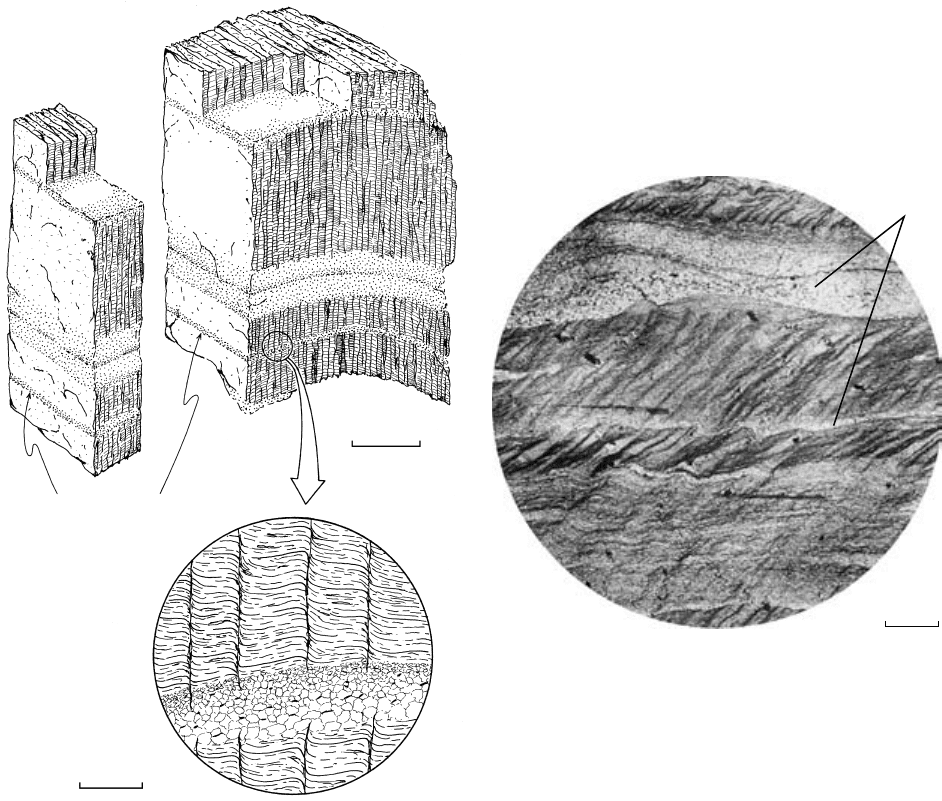
422 Igneous and Metamorphic Petrology
expelled from the solidifying carbonatite magma; equi-
libration required its dissolution in these fenitizing
fluids coupled with simultaneous precipitation of
more stable amphibole. (The alkali feldspar in the
granite appears to have been stable in the presence
of the fenitizing solutions.) However, throughout the
replacement process, the characteristic graphic out-
lines of the original quartz grains were faithfully pre-
served. Preservation of the relict protolith fabric,
coupled with the observation in the field of unreplaced
quartz farther from the carbonatite dike, beyond the
influence of the fenitizing solutions, is a crucial line
of evidence indicating the nature of the metasomatic
process.
Metasomatism is a significant change in the chemical
composition of a rock resulting from the replacement
14.18 Polymetamorphic slate with thin relict interbeds of weakly metamorphosed sandstone and siltstone. (a) Gently arched slaty cleavage in
slate that is subparallel with relict bedding is overprinted by a nearly perpendicular crenulation cleavage. Redrawn from Gilluly et al.
(1975). (b) Photomicrograph in plane-polarized light of a similar fabric except the crenulation cleavage has a smaller wavelength and
intersects the pre-existing slaty cleavage and paralleling relict beds at about 45°. Crenulations are not expressed in quartz-rich relict beds.
Relict silty
laminae
(b)
10mm
sandy
bed
Imposed
metamorphic
foliation
Relict
Trace of relict bed on foliation
02mm
20cm
(a)
14.1.5 Metasomatism
In the examples of metamorphism described thus far
there was little significant change in the chemical com-
position of the rock, except for the amount of water.
The nonvolatile chemical composition remained essen-
tially constant in closed rock systems; metamorphism
was isochemical.
Figure 14.21 illustrates another type of metamor-
phism in which a marked change in composition has
taken place. Quartz grains in graphic granite (Figure
7.20) wallrock next to a hot carbonatite dike (Figure
13.40) have been replaced by fine-grained aggregates of
sodic amphibole, resulting in an alkali-rich amphibole–
feldspar rock called fenite. The quartz was unstable
in the presence of the highly alkaline volatile fluid
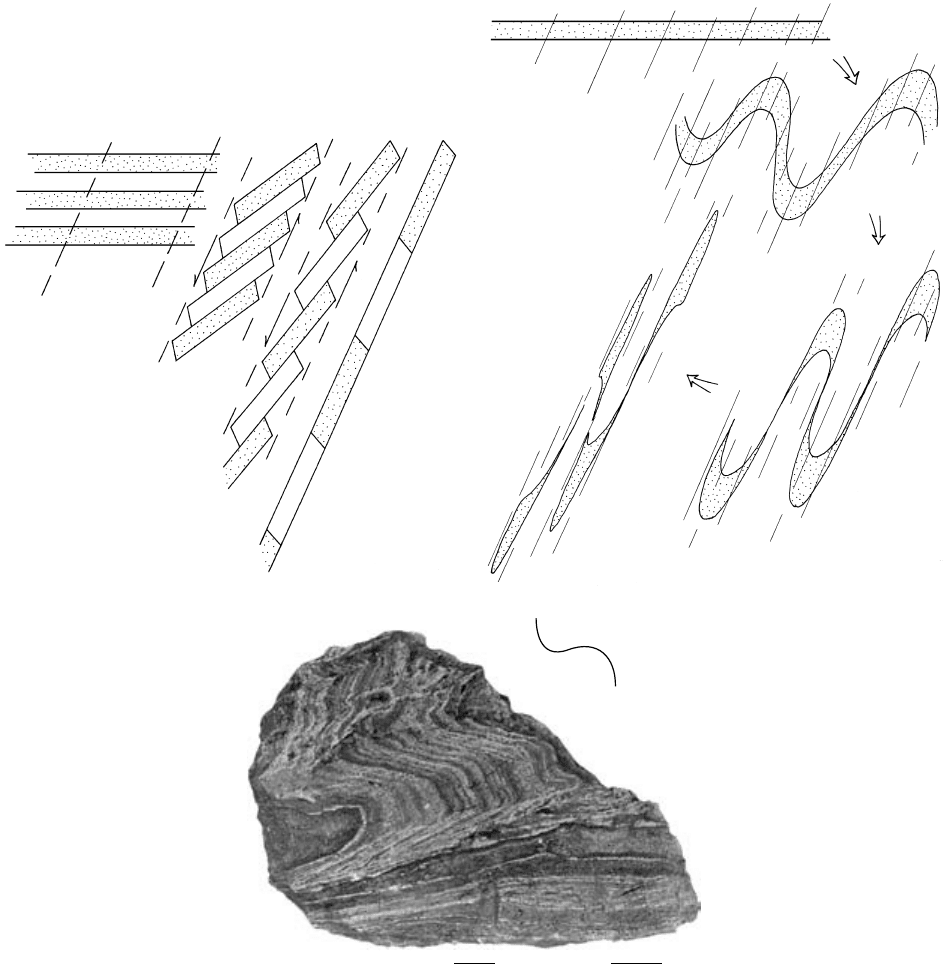
of original unstable mineral grains by others of dif-
ferent composition. In some cases, but not all, this is
a constant volume replacement which preserves the
form and the size of the original grains, as just
described. Metasomatism is usually made possible by
advective flow of large quantities of a fluid solution
through an open-system, permeable rock body. Integ-
rated over the time of the metasomatism, fluid/rock
ratios can be relatively large. Energy driving the advec-
tive flow can be thermal, as from a nearby cooling
magma, or gravitational, or both.
In contrast to the local metasomatism next to the
thin dike just described, global-scale metasomatic sys-
tems operate at oceanic ridges where seawater advects
through highly fractured hot basaltic rocks emplaced
along the rift (Special Interest Box 11.3), transforming
them, in part, into metasomatic rocks called spilite (see
Section 14.2.3).
Metamorphic Rocks and Metamorphism: An Overview
423
Initial foliation
(a)
New foliation
14.19 Transposed foliation. (a) Purely mechanical rotation of rigid slices of an initial layering produces a new foliation orientation. However,
this model is unrealistic because of the assumed rigidity of the slices and the voids created at the ends of the slices. (b) Progressively
tighter ductile folding transposes layer into a new foliation oblique to the initial one. (c) Hand sample showing transposition of a folded
layering into an oblique, planar, new layering. Note that this new foliation, as well as the one in (b), is parallel to the axial plane of
related folds.
Initial foliation
(b)
New foliation
Initial foliation
New foliation
(c)
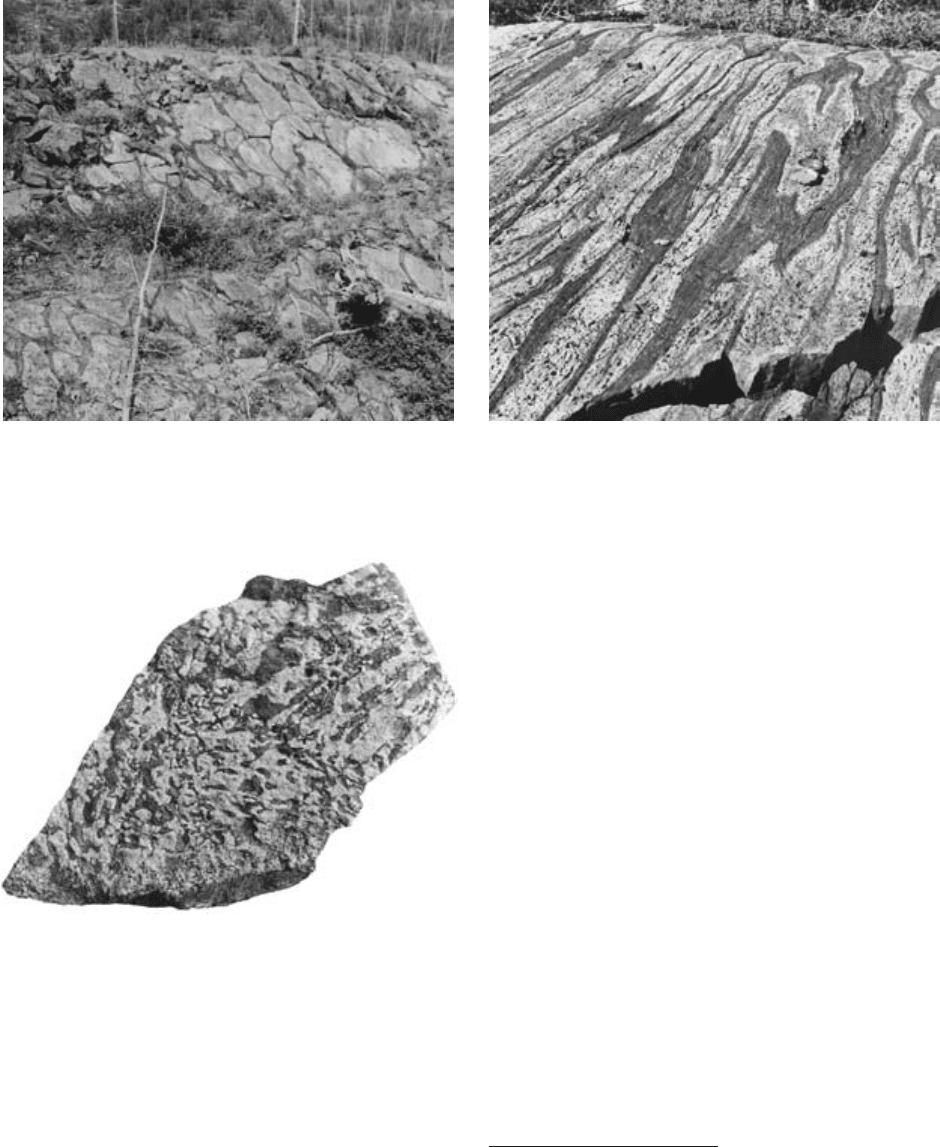
14.2 THE NATURE OF METAMORPHISM
The purpose in describing the foregoing examples of
metamorphic equilibration has been to create some
notion of the nature of metamorphic rocks and meta-
morphism. Obviously, the response of solid rocks to
changing conditions (changes in intensive variables
and state of stress) along metamorphic paths is infin-
itely variable. Not only do these changes range widely
but the character of protoliths is also highly variable.
Interestingly, however, contrasting protoliths and con-
trasting metamorphic paths can converge to a similar
metamorphic rock product. For example, a metamor-
phic path that involves extreme reduction in grain size
can produce a mylonite from a granitoid (Figure 14.16)
that resembles in terms of fabric a slate created by
slight metamorphism of a shale. Large volumes of a
particular advecting solution are potentially capable of
transforming different protoliths into virtually the same
metasomatic rock.
In the remainder of the chapter, significant facets of
metamorphic rocks and metamorphism—based in part
on observations of thin sections, hand samples, and
outcrops discussed above—are organized into a pre-
lude to more detailed discussions in following chapters.
14.2.1 The Nature of the Protolith
Protoliths of metamorphic rocks include virtually the
entire spectrum of magmatic and sedimentary rocks as
well as previously metamorphosed rocks, including
diverse metasomatic ones. Only sedimentary evaporites
and rare highly alkaline magmatic rocks are seemingly
not represented.
Sedimentary Differentiation. Sedimentary rocks have
formed by weathering and erosion of pre-existing
primary magmatic rocks since the earliest stages of
cooling of the infant Earth. Because rock-forming min-
erals in magmatic rocks respond in different ways to
weathering processes on the surface of the Earth their
decomposition produces compositionally diverse sedi-
ment. During this sedimentary differentiation, magmatic
424 Igneous and Metamorphic Petrology
(a) (b)
14.20 Metamorphosed Archean pillow basalts, Yellow Knife, Northwest Territories. Canada. (a) Undeformed but recrystallized pillows. (b)
Highly deformed lighter-colored pillows have been folded and transposed into elongate shapes. Brunton compass for scale. Geological
Survey of Canada photographs courtesy of Maurice Lambert and W. R. A. Baragar.
14.21 Metasomatized graphic granite in wallrock adjacent to a car-
bonatite dike (Figure 13.40). Quartz grains have been replaced
by fine-grained aggregates of sodic amphibole produced by
reaction with highly alkaline solutions expelled from the
carbonatite magma.
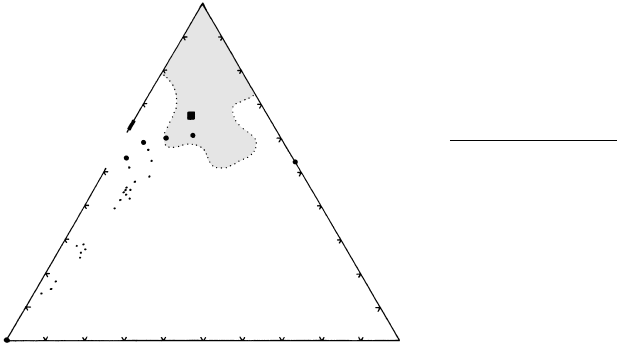
alumino-silicate minerals, especially widespread feld-
spars, decompose and hydrate into clay minerals (illite,
kaolinite, and montmorillonite in Tables 14.1 and A.2
in Appendix A). Clays are Al-rich minerals that contain
abundant (OH) and highly variable amounts of H
2
O
and H
2
O
. In widespread smectites, such as montmo-
rillonite, Mg, Fe, and K are also quite variable whereas
Ca and Na are minor constituents. Clays are the major
constituent of shales (pelitic rocks) together with lesser
quartz and carbonate minerals. Shales are more alum-
inous than most common magmatic rocks, as can be
seen in Figure 14.22 and Table 15.3. Ca and Na are
relatively soluble in surface waters and are removed
from decomposing magmatic minerals, eventually
being deposited as calcium carbonate (calcite and
metastable aragonite) and lesser gypsum and halite in
lakes and oceans. Quartz is relatively inert and is con-
centrated in sandstones along with residual feldspars
and other resistant minerals (e.g. zircon) plus lithic
fragments.
Because clays are derived from most of the rock-
forming alumino-silicate minerals in magmatic rocks,
shales are the most abundant sedimentary differentiate;
they actually constitute about half of all sedimentary
rocks. Sandstones make up about one-quarter, and cal-
careous limestones and dolostones (made of dolomite)
most of the remainder. Because the degree of weather-
ing and the extent of resulting sedimentary differenti-
ation vary, the compositional ranges of magmatic and
sedimentary rocks are not wholly distinct; they over-
lap to some extent. Thus, some lithic sandstones (e.g.
Figure 14.17a) in forearc–trench environments (see
Figure 14.24) may not differ much from the nearby
andesitic rocks from which they were derived.
Types of Protoliths. The following rock properties
allow recognition of protoliths:
1. Relict fabrics. In low-grade metamorphic rocks
where recrystallization has not created large new
grains or substantial deformation has not taken
place, boundaries of original grains (Figures 14.2
and 14.3) and outlines of fabric features such as pil-
lows in mafic subaqueous lava flows (Figure 14.20a)
have not been erased.
2. Field relations. In some instances, metamorphism
has progressed from an unmodified protolith into
rocks of increasing grade; this transition can be
observed in the field, such as in a contact meta-
morphic zone around a magmatic intrusion.
3. Bulk chemical composition manifested by the min-
eralogical and modal composition of the rock. This
may be the only clue to the protolith where critical
informative field relations are lacking and relict fab-
rics have been erased. Even if there has been sub-
stantial metasomatism, some constraint is possible,
perhaps in ratios of less mobile elements (Figure
2.22). Keeping in mind the continuous spectrum of
rock compositions, several discrete, “end-member”
protolith categories, or bulk chemical rock groups,
can be recognized, as follows:
(a) Ultramafic. Derived from high-Mg–Fe mag-
matic rocks—including peridotite, pyroxenite,
and dunite—composed of pyroxene and olivine
with limited or no feldspar. High-T metamor-
phic rocks are composed of these same min-
erals plus possible spinel and Mg–Fe garnet,
while lower T rocks contain combinations of
serpentine, talc, brucite, chlorite, tremolite, mag-
netite, and, where CO
2
fugacities are adequate
for stabilization, dolomite or magnesite.
(b) Mafic. Silicate rocks that have relatively high
concentrations of Mg, Fe, and Ca as well as
appreciable Al correspond to a basaltic (gab-
broic) protolith or, in some instances, a clay-
bearing dolostone or marl (mixed clay-carbonate
rock). Mg–Fe–Ca-rich minerals such as actino-
lite, hornblende, pyroxene, garnet, epidote,
plagioclase, chlorite, and pumpellyite are
abundant; Fe–Ti oxides may also be abundant.
Some petrologists refer to these rocks as
metabasites. Rare rocks of cordierite antho-
phyllite are believed to be metamorphosed
spilites that are created by metasomatism of
basalt at oceanic ridges.
Metamorphic Rocks and Metamorphism: An Overview
425
CaO + Na
2
O
K
2
O
Granite
Grano
diorite
K-feldspar
Average
shale
Hundreds of
analyses of
shale
Plagioclase
Andesite
Basalt
Al
2
O
3
Calcareous shales
Limestone
14.22 Chemical composition in wt.% of shales compared to average
common magmatic rocks (Table 2.2) and feldspars (Table A.1
in Appendix A). Shaded area encloses hundreds of analyses
of shale (from Hutcheon et al., 1998) that are mostly more
aluminous than common magmatic rocks and feldspars whose
decomposition yields clay minerals; relatively soluble K, Na,
and Ca are removed. Average shale from Table 15.3. Com-
positions of calcareous shales (dots) trend toward limestone
(calcite).
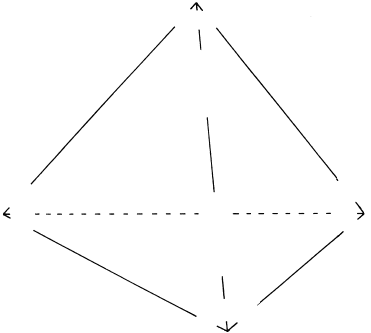
(c) Quartzo-feldspathic or felsic. Quartz- and
feldspar-bearing metamorphic rocks derived
from felsic magmatic rocks as well as felds-
pathic and lithic sandstones. Relatively minor
mafic minerals include biotite, chlorite, amphi-
bole, pumpellyite, stilpnomelane, and Fe–Ti
oxides. It should be realized that, without relict
fabrics and critical field relations, it may be
impossible to discriminate between protoliths
which include rhyolite lava, tuff, obsidian,
granite, porphyry, and different kinds of sand-
stones. Sandstone protoliths composed of quartz
and minor clay are sometimes called psammites.
(d) Pelitic. Rocks that have clay-rich shale (mud-
stone) protoliths and are characterized by
Al-rich silicates, such as Al
2
SiO
5
polymorphs,
cordierite, almandine garnet, and staurolite.
Quartz is almost always present with abundant
micas—both biotite and white mica—which
are only absent in rocks recrystallized at high-
est T, where combinations of alkali feldspar,
Al
2
SiO
5
polymorphs, Fe–Ti oxides, and pyr-
oxenes take their place. Graphite is conspicuous
in many pelites.
(e) Calcareous. Rocks derived from more or less
pure limestones and dolostones. Calcite and
dolomite in the absence of quartz and other
silicates are stable over a broad range of meta-
morphic conditions but as silicates and quartz
increase in modal abundance, calcareous rocks
grade into those of the next category.
(f) Calc-silicate. Rocks derived from impure
carbonate protoliths that contain substantial
proportions of clays and quartz in addition to
calcite and dolomite, or from more pure car-
bonate rocks metasomatized in contact aure-
oles (see skarns below). Metamorphic minerals
include carbonates of Ca, Mg, Fe, and locally
Mn plus numerous possible Ca-rich silicates
such as grossular–andradite garnet, vesuvianite,
epidote-group minerals, diopside–hedenbergite
solid solutions, wollastonite, and tremolite.
(g) Ferruginous. Rocks include enigmatic Pre-
cambrian banded iron formations and meta-
morphosed marine cherts. The former are
thinly bedded and composed chiefly of
quartz with subordinate hematite, mag-
netite, greenalite (Fe,Mg)
3
Si
2
O
5
(OH)
4
, min-
nesotaite Fe
3
Si
4
O
10
(OH)
2
, stilpnomelane,
riebeckite, Fe-chlorite, siderite, and ankerite
Ca(Mg,Fe
2
,Mn)(CO
3
)
2
. Metamorphosed cherts
are composed of quartz and accessory Fe–
Mn–silicates such as spessartine (Mn–Al gar-
net), piemontite (an epidote-like mineral), and
riebeckite.
14.2.2 Types of Metamorphism Based on
Metamorphic Conditions
A wide spectrum of changes in P, T, composition, and
state of stress cause protoliths to equilibrate to new
mineral assemblages and fabrics that constitute the
metamorphic rock. Although most metamorphism in-
volves changes in more than one of these parameters
along the metamorphic path, specific types correspond
to each parameter (Figure 14.23). Increase in T causes
thermal metamorphism. Infiltration into open rock
systems of chemically active fluids that create new
mineral assemblages is metasomatism, or, because
the fluids are hydrothermal solutions (Section 4.3.3),
hydrothermal metamorphism. Deformation resulting
from nonhydrostatic stresses can be focused in high-
strain-rate shear zones, causing dynamic metamor-
phism. Compounding the effects of heat and nonhy-
drostatic stress with subordinate changes in P and fluid
composition leads to dynamothermal metamorphism.
14.2.3 Geologic Field Settings: Metamorphic Terranes
Identification of the geologic settings where metamor-
phism occurred is a meaningful exercise as it allows us
to see what transfers of mass and heat were involved
and how they drove solid-state changes. Identifying
sites of metamorphism has a parallel in finding geologic
realms where partial melting can occur to localize
magmatism (Section 11.1). Metamorphic settings are
described in terms of the large-scale field relations of
metamorphic terranes, which are tracts of exposed
rock distinct in some way from adjacent rock masses.
Terranes vary in areal extent and the conditions and
426 Igneous and Metamorphic Petrology
NON-
HYDRO-
STATIC
STRESS
P
Dynamic
Thermal
Impact
T
M
e
t
a
s
o
m
a
t
i
s
m
FLUID ACTIVITY
Dynamo-thermal
Burial
Contact
Ocean ridge
Regional
14.23 Tetrahedron representing the controlling factors in metamor-
phism (capital letters at four apices), types of metamorphism
(lower case letters), and environments, or field settings, of
metamorphism (italicized lower case letters). Note that re-
gional metamorphism lies within tetrahedron because all four
factors are involved. Metamorphic equilibration processes are
also controlled by kinetic factors, which are not represented.
